Study on Lateral Nonlinear Dynamic Response of Deep water Drilling Riser with Consideration of The Vessel Motions in Its Installation
Yanbin Wang,Deli Gao,Jun Fang
Study on Lateral Nonlinear Dynamic Response of Deep water Drilling Riser with Consideration of The Vessel Motions in Its Installation
Yanbin Wang1,2,Deli Gao1,Jun Fang1
In this paper,the mechanical model to analyze the riser lateral vibration displacement and stress distribution in installation has been established via variational approach and the principle of minimum potential energy.In this model,the influence of vessel motion on riser lateral vibration has been taken into consideration.The specific expression of lateral vibration has also been figured out according to the boundary conditions and initial conditions.At last,the variations of riser maximum lateral displacement and stress distribution on water depth(WD),wave height,wave period,riser OD,BOPS weight have been discussed.
marine riser;installation process;lateral vibration;vessel motion
1 Introduction
Marine riser is the critical equipment connecting subsea wellhead and floating drilling platform(ship)in deepwater drilling.The correct installation directly relates to the service life of the riser and the success of deep-water drilling operation.With the increase of water depth,the riser stress state becomes more and more severe.The dynamic response of marine riser becomes the hot and difficult research of deep-water drilling.
Scholars have done quite a number of researches on riser dynamical response.Burke(1974)has deduced the riser mechanical deformation control differential equation with elastic mechanics method.Egeland,Wiik and Natvig(1982)have presented some methods for riser dynamical analysis.Bennett and Metcalf(1977)have made some nonlinear dynamic analysis of coupled axial and lateral motions of marine riser,and the analysis method allowed engineers to investigate riser pipe bucking stability.Simmonds(1980)has established a non-linear equation to analyze riser dynamical response and the equation has been solved by finite difference method.Azpiazu and Nguyen(1984)have analyzed the vertical dynamics of marine riser to determine the amplitude of dynamic forces and displacement caused by heave action.Trim(1991)has derived an equation of axial motion of a tensioned marine riser and a number of practical problems including the dynamic response following an emergency disconnection are considered.Moe and Larsen(1997a)haved derived an equation of motion for a marine riser undergoing large deflections and rotations.Moe and Larsen(1997b)have developed a differential equation describing the motions of marine riser with asymptotic solution.Athisakul,Huang and Chucheepsakul(2002)have presented a variational approach to two dimensional large strain static analysis of marine risers.Ertas and Kozik(1987)has proposed the riser dynamic differential equation,which was solved by the finite difference method.Khan and Ahmad(2006)has made some dynamic analysis of risers subjected to regular or irregular wave with ABAQUS software,and the variation of riser bending stress with low frequency drilling ship movement and wave motion and current velocity were also analyzed.Mathelin and De Langre(2005)have addressed the votex-induced vibrations with a wake oscillator mode and a theoretical analysis has been carried-out to predict the wave-packets amplitude and distribution.Shi and Chen(2004)have studied the riser strength with 3-D finite element model which is established with considering the characteristics of big deformation and small strain under combination action of lateral and axial force using non-linear theory.Chang(2008);Sun and Chen(2009);Ju,Chang,Chen,Xu and Yin(2011)have did some research on riser stochastic nonlinear dynamic response,hanging axial dynamic analysis and wave-induced long-term fatigue analysis with theoretical and numerical simulation method.Shouwei,Qingyou and Jiang(2013)have studied the mechanical properties of riser subjected to shear fl ow with experimental method and found the riser“one third effect”which can be explained through an analysis of the mechanical model and material mechanics theory.Namchchivaya(1989)has examined the non-linear behavior of supported pipes conveying pulsating fluid in the vicinity of sub-harmonic resonance.
The purpose for this paper is to analyze the riser lateral vibration characteristics during installation process.The analysis model has been established and differential equation has been deduced.In this model,the influences of the vessel motion on riser lateral vibration have been considerate.Analysis results allow engineers to grasp the riser actual state during its installation and to improve the riser mechanical state by changing some operation parameters.
1.1 Differential equation
After the conductor is installed,Lower Marine Risers Package(LMRP)and BOPS are lowered together with riser into the sea water to connect the subsea wellhead.In this process,the riser is subjected to both axial tension force generated by top tensioner,self-weight and BOPS weight and lateral force which is the source of riser lateral vibration generated by sea current and wave which change with time and water depth,as shown in Fig.1.

Figure 1:Riser lateral vibration analysis model
The analysis model can be regarded as a beam subjected to both non-uniform tension force and lateral force located in the vertical plane.The top of the beam is fixed and the end of the beam is a free end.Take the connection point of drilling ship and riser top as the origin of the coordinate,the positive direction ofxaxis is vertical to the bottom of the sea and the positive direction ofyaxis is the same as that of the lateral force.The differential equation of riser lateral vibration can be represented by Eq.1 which specific derivation process is shown in Appendix 1.

Where,EIis riser bending stiffness;y(x,t)is riser lateral vibration displacement;T(x)is the riser effective tension distribution along thexaxis;mis the total mass of the riser and contents per length;f(x,t)is the lateral force generated by wave and current per length.
The riser bottom can be regarded as a free end connected with LMRP and BOPS.The top of riser fixed on the floating drilling platform moves along with the vessel motion.It can be regarded as a beam with a free end mass.So,the boundary conditions of Eq.1 are:

Where,lis the riser total length;Jis the moment of inertia of riser per length in vibration plane perpendicular to the center axis;Mis the weight of LMRP and BOPs;S(t)is the lateral response of vessel motion.
1.2 Load analysis
According to Guesnon,Gaillard and Richard(2002),riser tension distribution during installation can be calculated by:

Where,GBOPSis the total weight of LMRP and BOPS in sea water;w(x)is the total weight of the riser and contents per length in sea water.
The lateral force generated by wave and current are determined from a modified form of the Morine equation[Zhu(1991)]which includes the relative velocities and acceleration of the water and riser.The lateral force can be approximated by the drag forcefDand inertia forcefM,which is:

Where,ρwis the sea-water density;Dis the riser outer-diameter;u=uw+uc,uwis the horizontal component of wave speed,ucis the horizontal speed of sea current;CDis drag force coefficient from Morison equation;CMis inertia force coefficient from Morison equation.
Vessel motion has a significant influence on riser dynamic characteristic.According to Sexton and Agbezuge(1976),the vessel motion includes three components:mean vessel offset from the well bore,a long-term-drift of vessel motion and the instantaneous response of the vessel to irregular waves.This paper focuses on the riser mechanical behavior during its installation which indicates that the horizontal response of vessel motion should be taken into account.So,the long-term-drift of vessel motion is mainly considered to simulate the vessel motion,which is:

Where,Slis the single amplitude of vessel drift,Sl=dis the water depth;Tlis the period of vessel drift,Tl=100is a phase angle between drift motion and wave(usually taken as zero).
2 Equation solution
According to the vibration theory,the main vibration mode depends on the system boundary conditions.In this problem,the top riser is fixed and the end of riser is free.In order to determine the main vibration,the homogeneous form of Eq.1 is:

Suppose the riser lateral vibration response can be expressed by the product of the main vibration modeY(x)and the variation of vibration with time functionT(t),which is:

The main vibration mode of riser in installation can be represented by:

Taking vessel motions into consideration,the riser lateral vibration equation can be calculated by:

According to the variational theory and the principle of minimum potential energy,the riser lateral displacementy(x,t)should be the minimum of functional equation,which is shown in Eq.18.After substituting Eq.9 into Eq.18 and doing integration term by term,the functional about Π can be written as undetermined constants aboutAi,which is:

The condition of making functional be minimalization is:

Thus,a system of linear equations aboutAiis obtained.After solving Eq.11,the undetermined constants aboutAiare all determined.Then,the riser lateral vibration equation is obtained after substituting all of theseAiinto Eq.9.
3 Case study and discussion
3.1 Case study
Taken an actual deep-water drilling operation for example,the WD is 1500m,the riser outer diameter is 533.4mm,the riser wall thickness is 15.875mm,the steel density is 7850kg/m3,the elastic modulus of steel is 206GPa,the sea water density is 1030kg/m3,the wave height is 15m,the wave period is 13s,the drag force coefficient is 0.8,the inertia force coefficient is 2.0,the weight of LMRP and BOPS is 200T.
According to Eq.5,the horizontal response of vessel motion under wave action is shown in Fig.2.According to the solution method mentioned above,the undetermined constants are:A1=24.9443,A2=-5.6828,A3=2.1300,A4=-1.1644,A5=0.6592,A6=-0.3737.Because the high order vibration mode coefficients have a characteristic of strong attenuation,only the first few order vibration modes can approximate the horizontal displacement of riser vibration response with high precision.The specific vibration equation can be represented by taking the first six order vibration modes into Eq.9.In order to analysis the influence of vessel motion on riser displacement,the maximum lateral vibration displacement under these two situations is shown in Fig.3.
As can be seen from Fig.3,vessel motion has a significant influence on riser lateral vibration.The actual riser vibration response is the sum of vessel motion and riser lateral vibration under the action of wave and current.So,the actual lateral displacement calculated with taking vessel motion into consideration(54.5m in this example)is bigger than that(18.9m in this example)regardless of vessel motion.

Figure 2:Horizontal response of vessel motion
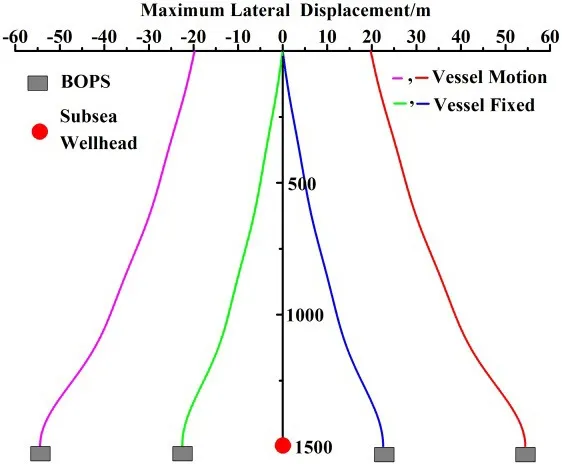
Figure 3:Riser maximum lateral vibration displacement
From this perspective,it is suggested that the influence of vessel motion should be taken into account when analyze riser lateral vibration displacement in installation.In order to obtain the riser stress distribution,the stress analysis should be carried out.There are two kinds of loads acting on riser:bending moment and axial tension force.According to mechanics of materials[Liu(2008)],bending moment induces bending normal stress.Axial tension force induces axial tension stress.The total stress is the sum of these two kinds of stress and the maximum point is located on the riser outer wall surface.The riser stress distribution of riser is shown in Fig.4.

Figure 4:Riser stress distribution
As shown in Fig.4,the bending normal stress induced by bending moment has a slight change under a certain water depth then increases gradually beyond this water depth.The axial tension stress declines gradually form sea surface to the mud line.However,the tension stress is always greater than the bending normal stress.So,the riser stress is given priority to the tension stress.In this example,the maximum stress value is 294MPa which locates on the top of riser.
3.2 Discussion
During riser installation process,there are many influence factors including operation factors and environment factors such as WD,riser size,BOPS weight,wave height and wave period,which can affect the lateral vibration displacement,In order to fully grasp the riser mechanical behavior,it is necessary to study how these influence factors affect the riser vibration displacement respectively.
(1)Water depth
Water depth is the first factor needed to consider in offshore drilling.With the development of offshore drilling technology,water depth increases gradually.In order to get the riser lateral vibration displacement under different water depth,the variations of maximum lateral displacement with water depth ranges from 500m to 3000m are shown in Fig.5 and the variations of total stress distribution with water depth are shown in Fig.6.
As can be seen from Fig.5,the horizontal vessel locations are different when riser has maximum value of lateral vibration displacement under different water depth.With the increase of water depth,the single amplitude of vessel drift becomes big-ger which results to increase displacement of riser lateral vibration. In this example,the riser maximum lateral displacement is 18.9m when the horizontal displacement of vessel is18.9m in 500m water depth.However,the riser maximum lateral displacement is up to 97.0m when the horizontal displacement of vessel is almost 49.9m in 3000m water depth.So,the vessel motion has a significant influence on riser lateral displacement.As can be seen from Fig.6,water depth is also of great importance to riser stress distribution.specifically,the deeper the water depth is,the severer the riser stress state is.Taking 500m water depth as an example,because the bending normal stress generated by the bending moment is greater than the tension stress produced by axial force,the maximum stress point locates almost on riser bottom rather than on the top of riser.The stress at riser top is 149MPa while that at riser bottom is 181MPa.Besides,the stress distribution has a dramatic change along riser.There is a certain water depth which the tension stress produced by axial force is greater than bending normal stress generated by the bending moment under a certain ocean environment.Under this circumstance,the maximum stress point locates on the top of riser rather than at riser bottom.When the water depth is small,the riser stress declines with the water depth to a certain depth then the riser stress increases gradually.However,this phenomenon disappears with the increase of water depth.This is because with the gradually increases of water depth(taking 3000m water depth for example),the tension stress is far greater that the normal bending stress which results to the riser stress is given priority to the tension stress,and the total stress distribution is very similar to the tension stress distribution.According to the standard of DNV-OS-F101(2000),the main material of deep-water drilling riser is API 5L X80 pipeline steel,and the minimum yield strength is 555 MPa.In this example,when the water depth is 3000m,the total riser stress is as great as 513 MPa,which indicates that the riser stress state is very severe and the installation operation must be carried out very carefully.
(2)Wave parameters
Wave also has great changes in the same sea area.So,it is necessary to study the influence of wave parameters(wave height and wave period)on riser mechanical behavior.The variations of riser displacement and stress distribution with wave height ranges from 5m to 25m are shown in Fig.7 and Fig.8.The variations of riser displacement and stress distribution with wave period ranges from 4s to 24s are shown in Fig.9 and Fig.10.
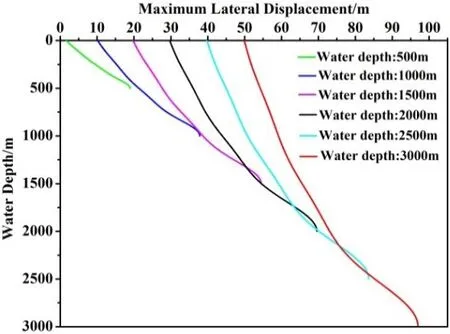
Figure 5:Variations of riser maximum lateral displacement with water depth

Figure 6:Variations of riser total stress with water depth
As can be seen from Fig.7,wave height has great impact on riser lateral vibration characteristic.specifically,the bigger the wave height is,the bigger the riser maximum lateral displacement is.What’s more,no matter what the wave height is,the riser maximum lateral displacement always appears at riser bottom which indicates that the distance between BOPS and subsea wellhead is the maximum one when the riser is lowered down to the mud line.In this example,the distance between BOPS and subsea wellhead is 26.3m when riser lowered to the mud line under the condition of 5m wave height while the distance is as bigger as 103.0m when the wave height is 25m.However,the impact of wave height on riser stress distribution is not such dramatic as shown in Fig.8.

Figure 7:Variations of riser maximum lateral displacement with wave height
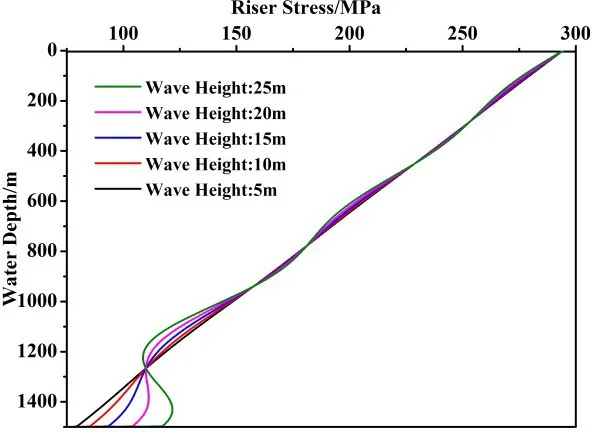
Figure 8:Variations of riser stress with wave height
As shown in Fig.9,with the increase of wave period,the riser maximum lateral vibration displacement increases gradually.However,the vessel horizontal displacement remains the same when riser has maximum value of lateral displacement.In this example,the distance between BOPS and subsea wellhead is 46.5m when wave period is 4s while the distance is 63.9m when the wave period is 24s.However,the vessel horizontal displacements are all 19.8m under these two conditions.Wave period has almost no influence on riser stress distribution as shown in Fig.10.
(3)Riser OD

Figure 9:Variations of riser maximum lateral displacement with wave period
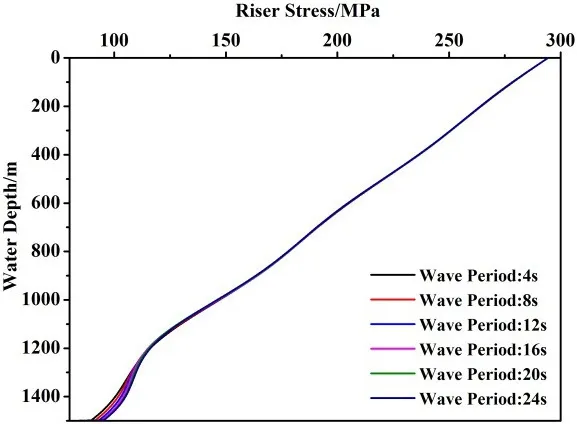
Figure 10:Variations of riser stress with wave period
As can be seen in Fig.11,the bigger the riser outer diameter is,the bigger the riser maximum lateral displacement is when the riser wall thickness is constant.The influence of riser outer diameter on lateral displacement has two aspects:riser self-weight and bending stiffness increase has an impact to reduce the riser lateral displacement on the one hand.However,on the other hand,lateral force per unit length generated by wave and current increases which has an impact to increase the riser lateral displacement as shown in Eq.4.The comprehensive effects of these two influences are to make riser lateral displacement increases with its outer diameter.The maximum point of riser stress locates at the riser top as shown in Fig.12.The bigger the outer diameter is,the bigger the riser stress maximum value is.Besides,bigger riser outer diameter means bigger top tension needed to provide by top tensioner.So,in the case of other requirements are met,the smaller riser outer diameter can be a better choice.
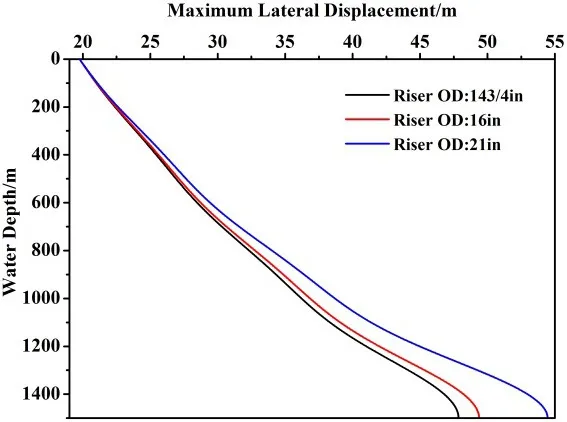
Figure 11:Variations of riser maximum lateral displacement with riser outer diameter
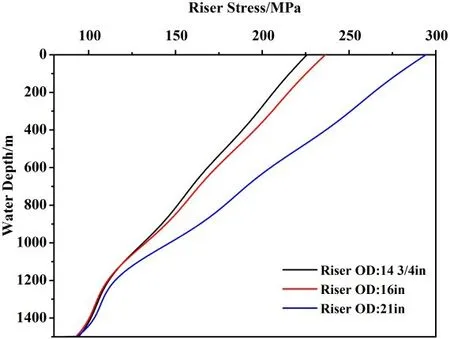
Figure 12:Variations of riser stress with riser outer diameter
(4)BOPS weight
The variations of riser maximum lateral displacement and stress distribution on BOPS weight ranges from 100T to 300T are shown in Fig.13 and Fig.14.As shown in Fig.13,with the increase of BOPS weight,riser maximum lateral displacement declines gradually.This is because the tension force generated by BOPS weight has an impact to straighten the riser.As can be seen in Fig.14,the heavier the BOPS is,the riser maximum stress is.Besides,the maximum point of riser stress always locates at the top of riser and decline gradually along water depth.So,in the case of other requirements satisfied,BOPs with bigger self-weight can be a better choice.
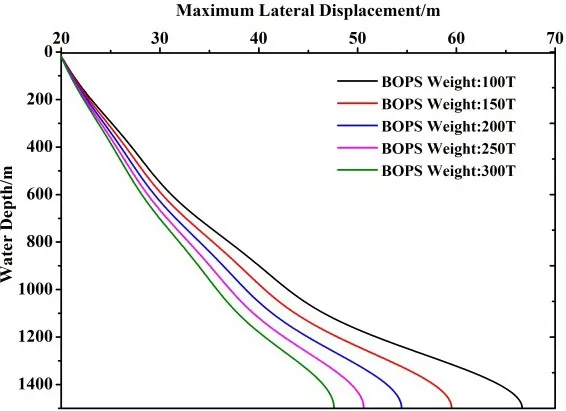
Figure 13:Variations of riser maximum lateral displacement with BOPS weight

Figure 14:Variations of riser stress with BOPS weight
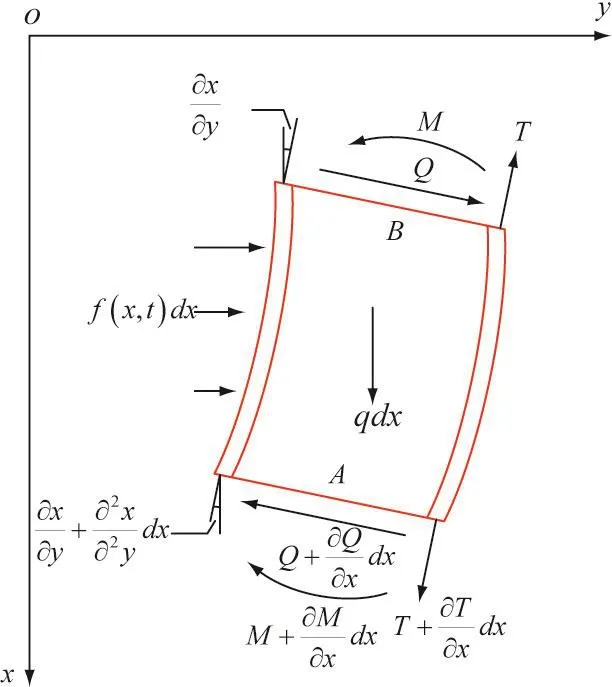
Figure 15:Riser micro body analysis model
4 Conclusions
(1)The mechanical model to analyze the riser lateral vibration displacement and stress distribution in installation has been established via variational approach and the principle of minimum potential energy.In this model,the influence of vessel motion on riser lateral vibration has been taken into consideration.The specific expression of lateral vibration has also been figured out according to the boundary conditions and initial conditions.
(2)Riser maximum lateral vibration displacement augments with the increase of water depth,riser OD,wave height and wave period and declines with the increase of BOPS weight.Riser stress will increases with the increase of water depth,riser OD and BOPS weight.However,wave height and wave period have slight influence on riser stress.Water depth and wave height are the first two factors needed to consider carefully in installation.The study of this paper has some reference value to realize safe and quick installation of marine riser.
Acknowledgements:The authors gratefully acknowledge the financial support from the Natural Science Foundation of China(NSFC,51221003,U1262201).This research is also supported by other projects(Grant numbers:2013AA064803,2011ZX05009-005).
Appendix 1
In order to obtain the riser differential equation during installation,a micro body with length dx is cut off at the water depthxfrom the sea surface,and the force analysis of the micro body is shown in Fig.15.The differential equation will be deduced from the point view of energy as flows:
(1)Strain energy
During riser installation process,the strain energy is generated mainly because of the work done by riser bending moment,tension force and shear force.Because the riser out diameter is far less than its length,the riser can be regarded as Euler-Bernoulli beam and the contribution of shear force to strain energy can be ignored.The strain energy generated due to riser bending moment can be calculated by:

The strain energy generated due to riser tension force can be calculated by:

So,the total strain energy is the sum of work done by bending moment and tension force,which is:

(2)Work done by external force
The external forces include wave and current force,gravity and buoyancy force during riser installation.Among these external forces,only wave and current force could do work.Riser vibrates under the action of alternating load generated by wave and current force changing with time.Suppose m is the riser mass of per length,then the kinetic energy of micro body is:

The combination force of wave and current is the external force acting on riser,which is the function of water depthxand timet.The work done by the combination force to the micro body is:

According to the relationship of work-energy,the energy of micro body is:

Suppose the riser vibration period of a certain order is τ,then the riser energy in one vibration period can be calculated by:

As shown in Eq.9,Π is the functional on riser vibration curvey(x,t).According to the principle of minimum potential energy,the possible vibration curvey(x,t)should make the functional be minimalization.So,this is a variational problem of functional Π.The necessary condition of making functional be minimalization is that the functional should satisfy the Euler-equation,which is:

So,the riser vibration differential equation can be represented as:

Athisakul,C.;Huang,T.;Chucheepsakul,S.(2002):Large strain static analysis of marine risers via a variational approach.InThe Twelfth International Offshore and Polar Engineering Conference.International Society of Offshore and Polar Engineers.
Azpiazu,W.;Nguyen,V.(1984):Vertical dynamics of marine risers.InOffshore Technology Conference.Offshore Technology Conference.
Bennett,B.E.;Metcalf,M.F.(1977):Nonlinear dynamic analysis of coupled axial and lateral motions of marine risers.InOffshore Technology Conference.Offshore Technology Conference.
Burke,B.G.(1974):An analysis of marine risers for deep water.Journal of petroleum technology,vol.26,no.04,pp.455-465.
Chang,Y.(2008):Design Approach and Its Application for Deepwater Drilling Risers.PhD thesis,Ph.D.Thesis,China University of Petroleum.(in Chinese),2008.
DNV-OS-F101(2000):Standard,dnv offshore.Submarine Pipeline Systems,Det Norske Veritas.
Egeland,O.;Wiik,T.;Natvig,B.(1982):Dynamic analysis of marine risers.InOffshore South East Asia Show.Society of Petroleum Engineers.
Ertas,A.;Kozik,T.(1987):Numerical solution techniques for dynamic analysis of marine riser.Journal of Energy Resources Technology,vol.109,no.1,pp.1-5.
Guesnon,J.;Gaillard,C.;Richard,F.(2002):Ultra deep water drilling riser design and relative technology.Oil&Gas Science and Technology,vol.57,no.1,pp.39-57.
Ju,S.-D.;Chang,Y.-J.;Chen,G.-M.;Xu,L.-B.;Yin,Z.-M.(2011):Determination methods for the top tension of ultradeepwater drilling risers.Ocean Engineering(Haiyang Gongcheng),vol.29,no.1,pp.100-104.
Khan,R.A.;Ahmad,S.(2006):Nonlinear dynamic analysis of deep water marine risers.InProceedings of the 2nd International Congress on Computational Mechanics and Simulation,Cuwahati,India.
Liu,H.(2008):Mechanics of Materials.Beijing:Higher Education Press.
Mathelin,L.;De Langre,E.(2005):Vortex-induced vibrations and waves under shear flow with a wake oscillator model.European Journal of Mechanics-B/Fluids,vol.24,no.4,pp.478-490.
Moe,G.;Larsen,B.(1997):Dynamics of deep water marine risers-asymptotic solutions.InThe Seventh International Offshore and Polar Engineering Conference.International Society of Offshore and Polar Engineers.
Moe,G.;Larsen,B.(1997):Dynamics of deep water marine risers-asymptotic solutions.InThe Seventh International Offshore and Polar Engineering Conference.International Society of Offshore and Polar Engineers.
Namchchivaya,N.S.(1989):Non-linear dynamics of supported pipe conveying pulsating fluid-i.subharmonic resonance.International Journal of Non-Linear Mechanics,vol.24,no.3,pp.185-196.
Sexton,R.M.;Agbezuge,L.(1976):Random wave and vessel motion effects on drilling riser dynamics.InOffshore Technology Conference.Offshore Technology Conference.
Shi,X.;Chen,P.(2004):influence of 3-d loads on strength of marine riser for offshore deep drilling.Nat.Gas Ind.,vol.12,no.3,pp.86-88.
Shouwei,Z.;Qingyou,L.;Jiang,W.(2013):The discovery of“one third effect”for deep water drilling riser:based on the theoretical and experimental study of the deformation characteristics of deep water drilling riser by ocean currents.China Offshore Oil and Gas.
Simmonds,D.(1980):Dynamic analysis of the marine riser.
Sun,Y.-y.;Chen,G.-m.(2009):Research on wave-loading fatigue of drilling riser in ultra-deep water drilling.Acta Petrolei Sinica,vol.30,no.3,pp.460-464.
Trim,A.(1991):Axial dynamics of deep water risers.InThe First International Offshore and Polar Engineering Conference.International Society of Offshore and Polar Engineers.
Zhu,Y.(1991):Ocean engineering wave mechanics.Tianjin University Press.
1MOE Key Laboratory of Petroleum Engineering in China University of Petroleum,Beijing,102249,China
2Corresponding author.Tel.:+86(10)89733702;E-mail:wyb576219861@126.com
 Computers Materials&Continua2015年10期
Computers Materials&Continua2015年10期
- Computers Materials&Continua的其它文章
- Development and Optimization of an Unstructured Kinetic Model for Sodium Gluconate Fermentation Process
- On the Buckling Response of Offshore Pipelines under Combined Tension,Bending,and External Pressure
- Minimizing Thermal Residual Stress in Ni/Al2O3 Functionally Graded Material Plate by Volume Fraction Optimization
